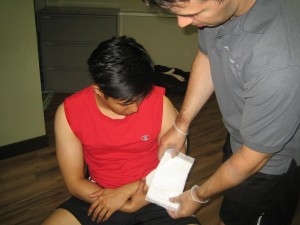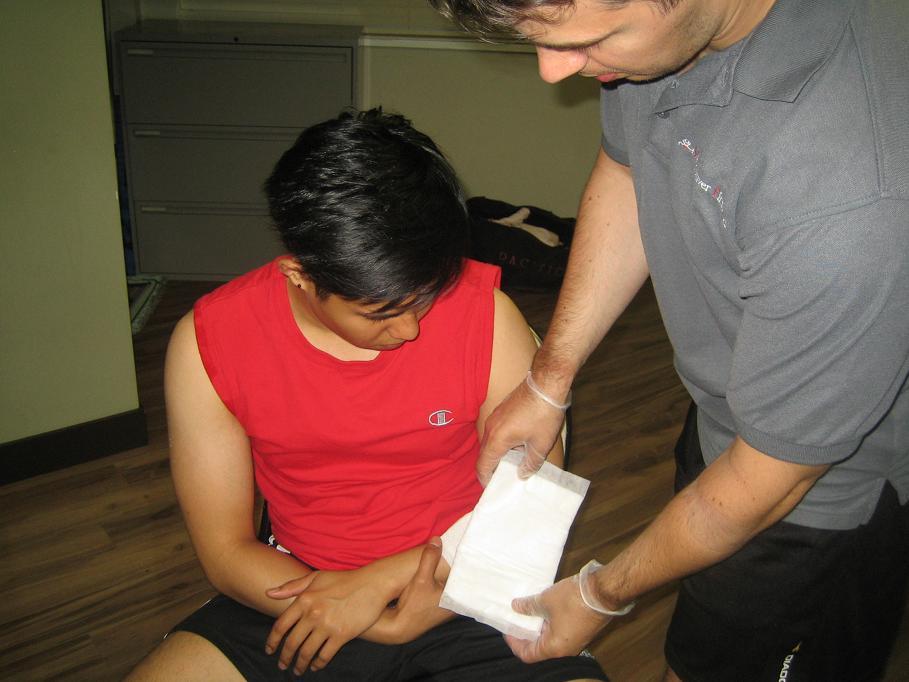http://www.youtube.com/watch?v=a2zwU2c-HZo
Severe bleeding can become a major cause of emergency. The situation definitely becomes an emergency when the bleeding is profuse and cannot be stopped by some gauze. When bleeding is severe rescuers and / or victims should call for help immediately. Even small wounds can result in heavy bleeding depending on the location of the wound. The scalp for instance, can cause a lot of bleeding even when the cut is small. It is wiser not to underestimate the presence of bleeding and apply the PRICE principle to help lessen the bleeding until help comes.
The material posted on this page for treating wounds and bleeding is for learning purposes only. To learn to recognize and manage severe bleeding emergencies sign up for first aid training near you.
First Aid Treatment for Bleeding

PRESSURE. Applying direct pressure using a sterile cotton or gauze mostly stop the bleeding. In cases of emergency, any clean clothing or handkerchief can be used too. Continuous, firm pressure must be applied for at least 20 minutes. Moreover, use adhesive tape or bandage to maintain the pressure. If possible, it is important to use washed hands or gloves in treating open wounds to avoid infection. If bleeding continues, just add more absorbent material over the soaked one. For severe bleeding, a tourniquet can be applied above the site, but be careful in doing so because it can cause a loss of an extremity if applied improperly.
REST. Immobilize the injured extremity to control blood loss, especially after the bandages have been applied and secured. Resting the bleeding extremity is also important during transportation of the patient because movement can encourage more bleeding to occur.
ICE. Applying ice promotes constriction of the blood vessels. Thus, lesser blood can be loss from the site of injury. Ice packs are usually placed directly over the covered wound or above the wound.
CHECK. Checking the patient and the injury is the most important thing to do during bleeding emergencies. Signs and symptoms of shock should be initially identified and if there are any, the patient must be immediately brought to the nearest emergency room for further treatment. Take note that for patients with bleeding disorders, such as Hemophilia A, they should be immediately brought to the nearest hospital even for minor wounds / bleeding.
Signs and symptoms of shock:
- Confusion
- Cool, moist, clammy skin
- Increased or rapid heart rate
- Increased or rapid breathing
- Low blood pressure
- Decreased urine output
- Pale skin or pallor
- Thirst
- Diaphoresis (Increased sweating)
ELEVATE. Elevate the injured part to stop bleeding from the veins and capillaries. If it is also possible, the patient should be placed in a Tredelenburg position where the patient’s head is positioned lower than the trunk. This can also be done by elevating the patient’s legs.
Causes of bleeding
Bleeding is apparently characterized by blood loss. Bleeding that is external caused by cuts, punctures, incisions, abrasions, lacerations, etc. can be easily managed depending on the length, width, and depth of the severed area. However, the most dangerous bleeding of all is internal bleeding. If internal bleeding is suspected, consider this as an emergency situation and immediately bring the patient to the hospital. Also, for patients taking anticoagulants such as aspirin, heparin, warfarin, etc., it is important to report right away any form of bleeding to your primary care physician.
References:
Emedicinehealth. Shock. Retrieved June 23, 2014 from http://www.emedicinehealth.com/shock/article_em.htm.

